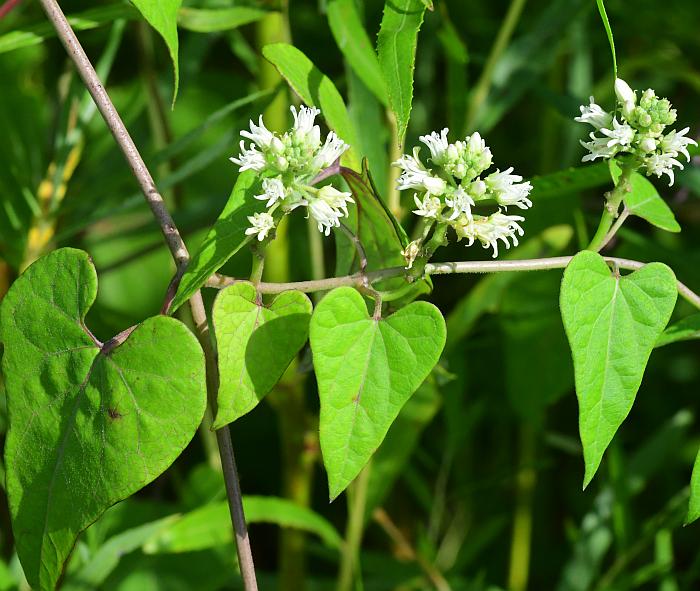Cynanchum laeve (Michx.) Pers.
Climbing Milkweed

Native
CC = 0
CW = 0
MOC = 52
© SRTurner
Cynanchum laeve (Michx.) Pers.Climbing Milkweed | |
 |
Native CC = 0 CW = 0 MOC = 52 |
© SRTurner |
|
Family - Asclepiadaceae Stems - Twining, climbing, to 10 m, with clear sap, sparsely to moderately hairy, at least toward the tip, usually in longitudinal lines.
Leaves - Opposite, simple, petiolate. Petioles to 7 cm long, sometimes reddish. Blades 2-10 cm long, triangular-ovate to broadly ovate, the base deeply cordate, the basal lobes broadly rounded, the sinus of well-developed leaves often quadrate, glabrous or sparsely short-hairy, mostly along the veins.
Inflorescences - Axillary umbellate clusters of 5-40 flowers. Peduncles to 5 cm long, pubescent. Pedicels to 1 cm long, pubescent.
Flowers - Calyx lobes 1.5-3.0 mm long. Corolla deeply 5-lobed, the lobes 4-7 mm long, narrowly oblong to lanceolate, glabrous. Corona modified into 5 erect, lateral, petaloid segments, each segment 4-6 mm long, white, the basal portion oblong-ovate, the apical 1/3-1/2 divided into 2 erect, linear lobes.
Fruits - Follicles 8-14 cm long, ovate to teardrop-shaped in outline, glabrous. Seeds with the body 7-9 mm long, obovate in outline.
Flowering - July - September. Habitat - Bottomland forests, streambanks, pond margins, fields, gardens, fencerows, roadsides, railroads, open disturbed areas. Sometimes cultivated. Origin - Native to the U.S. Lookalikes - None. Other info. - This species is present across much of Missouri, common in some areas, uncommon or absent in much of the Ozarks. Beyond Missouri its range is somewhat scattered, primarily within the U.S. Midwest. The plant is easily identified by its vining habit, opposite leaves which often have a deeply indented base with squared-off sides and small inflorescences of white flowers. Somewhat surprisingly, the flowers are very aromatic, with a pleasant floral scent. A vigorously flowering plant can perfume the air for a radius of several meters. Photographs in St. Louis, MO., 7-28-03 (DETenaglia); also along the Katy Trail near Dutzow, Warren County, MO, 8-3-2012, Riverfront Park, Washington, Franklin County, MO, 7-17-2020, and Duck Creek Conservation Area, 8-17-2021 (SRTurner). |